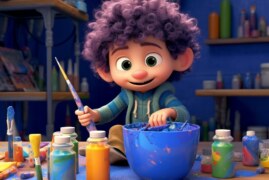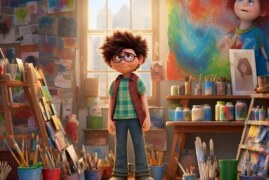Drawing a picture can be a fun and rewarding activity, but many people are intimidated by the thought of putting pencil to paper. Whether you’re a complete beginner or simply looking to improve your existing skills, this article will offer some helpful tips and advice on how to draw a picture from start to finish. From choosing your subject and gathering your materials to sketching out your composition and adding details, you’ll learn the basic steps involved in creating a beautifully rendered drawing. So grab your pencils and get ready to unleash your inner artist!
1. Introduction: Understanding the basics of drawing
Drawing is an art form in which lines and shapes are used to create images on paper, canvas, or other surfaces. It is a skill that requires practice and patience but can be learned by anyone with an interest in art. In this section, we will explore the basic elements of drawing that are essential for creating any artwork.
One of the most important aspects of drawing is understanding the tools used for this art form. To start with, you will need a pencil and paper. While selecting a pencil, the hardness or softness of the graphite is significant- harder pencils make lighter lines, while softer ones create darker lines. Graphite pencils are available in various grades, such as H for harder pencils, and B for softer ones. Additionally, you will also need an eraser, sharpener, and ruler to help you create straight lines.
In drawing, you will encounter many terminologies used to describe the various techniques and methods used. Learning these terms and their applications will help you to improve your creative ability- from shading and hatching to stippling and cross-hatching. Moreover, you will also understand the use of various lines in drawing- thin, thick, wavy- to produce the desired effect. With that said, understanding the basics of drawing is crucial for creating meaningful artwork that can communicate your artistic vision to others.
2. Selecting the right materials and tools for your project
When it comes to DIY projects, selecting the right materials and tools can make a huge difference in the success of the project. Here are some tips on how to select the right materials and tools for your project.
Materials:
-Consider the purpose of your project, and what type of materials would be best suited for it. For example, if you are building a outdoor shed, you would want to use durable, weather-resistant materials.
-Don’t skimp on quality when it comes to materials. It might be tempting to use cheaper materials to save money, but this can end up costing more in the long run if they end up needing to be replaced.
-Consider the style of your project. Will it be rustic or modern? Classic or trendy? Make sure the materials you select fit the desired aesthetic.
Tools:
-Make sure you have all the necessary tools to complete the project. This includes not only the basics, like a hammer and screwdriver, but also any specialized tools that might be needed for your specific project.
-Don’t skimp on quality when it comes to tools either. A good, durable tool can last a lifetime and make all the difference in the success of your project.
-Consider safety when selecting tools. Make sure you have the necessary safety equipment, like gloves and goggles, and make sure you are familiar with how to use all tools safely.
By following these tips, you can ensure that you select the right materials and tools for your project, setting yourself up for a successful DIY experience.
3. Sketching techniques to bring your ideas to life
Sketching is an essential skill for designers, architects, artists, and anyone who wants to bring their ideas to life. As a beginner, you may find it difficult to put your thoughts on paper. However, with a little bit of practice and patience, you can master the art of sketching. Here are some simple techniques to help you get started.
1. Start with basic shapes: Before you start sketching, break down your idea into basic shapes such as circles, squares, and triangles. This will help you get the proportions and angles right. Use light lines and don’t worry about making mistakes.
2. Use shading: Shading can bring depth and dimension to your sketch. Use pencil strokes to create light and dark areas. Pay attention to the direction of light and shadows.
3. Experiment with different tools: Don’t limit yourself to just one type of instrument. Try using different pencils, pens, markers, and brushes. Each tool will give a unique texture and line quality to your sketch.
4. Practice regularly: Sketching is a skill that requires practice. Set aside some time every day to sketch. Whether it’s on a napkin or a sketchbook, the important thing is to keep practicing.
Remember, the goal of sketching is not to make a perfect drawing, but to communicate your ideas visually. By using these techniques, you can bring your ideas to life and create stunning sketches that impress your clients and colleagues.
4. Adding depth and texture using shading and color
One of the most important techniques in adding depth and texture to a drawing is using shading and color. Shading involves creating the illusion of depth and dimension by darkening certain areas to create shadows, while leaving other areas much lighter. This technique can make an object appear three-dimensional and realistic.
Color is another essential element when creating depth and texture in a drawing. Choosing the right colors and using them in the right way can help create the illusion of depth and texture. For example, using warm colors like reds and oranges can make an object appear closer, while cool colors like blues and greens can make it appear farther away.
When combining shading and color, different effects can be achieved. Adding darker colors to the shadiest areas can make the objects look denser and create the illusion of texture. Meanwhile, by lightening the shaded areas slightly, highlights can be created which make objects appear shiny and reflective. By using proper shading techniques and color combinations, artists can add depth and texture that makes the objects in their drawings appear more realistic and believable.
5. Tips for creating realistic and visually appealing artwork
Creating realistic and visually appealing artwork can be a tricky task, but with the right techniques, it can be achieved. Here are some tips that you can follow to create a stunning piece of artwork:
– Observe Your Environment: The first tip for creating realistic artwork is to observe your environment. Take a close look at the objects and surroundings that you want to include in your artwork. This will help you to understand how light interacts with different surfaces and how shadows are formed. Pay attention to the details, such as textures, colors, and patterns.
– Use References: The second tip is to use references. Whether you are creating a digital or traditional artwork, references can be very helpful. You can use photographs, videos, or even real-life objects for reference. This will help you to get a better understanding of the subject and create a more realistic artwork.
– Experiment with Different Techniques: The third tip is to experiment with different techniques. Don’t be afraid to try out different styles and techniques until you find the one that suits your artwork the best. For example, you can use different brush strokes, shading techniques, and color palettes to create a unique artwork. However, make sure that the final result is visually appealing and does not compromise on the realism of the artwork.
In conclusion, creating a realistic and visually appealing artwork is all about paying attention to the details, using references, and experimenting with different techniques. By following these tips, you can create a stunning artwork that will leave a lasting impression on the viewers.
6. Practicing and honing your skills to become a better artist
Improvement is a continuous process for any artist, and practicing regularly is essential for honing their skills. Here are some tips that can help artists to enhance their abilities and become better:
- Experiment with different media: Trying various media like watercolors, pencils, or pastels can help you explore your potential and develop new techniques. You may also discover a medium that suits your style, and you can advance further in it.
- Take inspiration from other artists: Studying the work of others and learning from their strengths and weaknesses can broaden your perspective and inspire you to try new things. You can also seek feedback from peers and mentors, which can help you improve your artwork.
- Draw from life: Working from real-life objects, models, or landscapes can teach you about shadow, light, composition, and other crucial aspects of art that you may not encounter while working from photographs or your imagination.
Practicing regularly is the key to becoming a better artist. Although progress may seem slow at times, every bit of practice counts towards improvement. Consistency and dedication are essential elements to build a successful art career. Keep pushing yourself out of your comfort zone and stay curious to become a better artist.
7. Conclusion: Embracing the joy and creativity of drawing
After exploring the various aspects and benefits of drawing, it’s clear that it can be an excellent source of joy and creativity. Whether you’re a beginner or an experienced artist, there’s always something new to learn and discover. Drawing provides an outlet for self-expression, and it’s an excellent way to relieve stress and anxiety.
It’s important to note that drawing is not about being perfect or creating a masterpiece every time. It’s about the process of putting pen to paper and letting your imagination run wild. Don’t be afraid to experiment with different techniques, styles, and mediums. Allow yourself to make mistakes and learn from them.
- Practice regularly: The more you draw, the better you’ll get. Make it a habit to draw every day, even if it’s just for a few minutes.
- Take risks: Don’t be afraid to try something new or push yourself out of your comfort zone. Experiment with different styles and techniques.
- Seek inspiration: Look for inspiration in everyday life, whether it’s nature, people or objects around you. Take time to observe the world around you and incorporate what you see into your drawings.
Overall, drawing is a rewarding and fulfilling hobby that can provide a sense of accomplishment and satisfaction. Embrace the joy and creativity that drawing can bring, and make it a regular part of your life.
People Also Ask
1. What are the basic steps to draw a picture?
Begin with a simple outline of the subject, then add details and shading. Use light and dark values to create depth and contrast. Practice regularly and seek inspiration from other artists.
2. What are some essential drawing tools for beginners?
Some essential drawing tools for beginners include pencils of varying grades, erasers, paper, and a sharpener. Colored pencils, markers, and charcoal may also be useful for certain styles of drawing.
3. How can I improve my drawing skills?
Improving drawing skills may involve practicing regularly, studying the work of other artists, experimenting with different techniques and mediums, attending workshops or classes, and soliciting feedback from other artists.
4. What are some common mistakes beginners make when drawing?
Common mistakes beginners make include not focusing on proportions, being too heavy-handed or not pressing hard enough with the pencil, using too many line strokes, and neglecting shadows and shading.
5. Should I sketch lightly or with firm pressure?
It is generally best to sketch lightly, using light pressure to create outlines and the basic structure of the drawing. Firm pressure can be used later to add details and shading.
Conclusion
Drawing is a rewarding and versatile skill that can be learned with practice and dedication. Whether you are a beginner or an experienced artist, there is always room to grow and improve. By investing in quality tools, studying the work of other artists, and practicing regularly, anyone can create beautiful and compelling drawings. So pick up your pencil and start drawing today!



